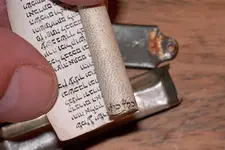ivan salis said:
-- its a MEZUZAH -- the 10 commandments (god's laws)--written in hebrew --in a little container -- posted on the door post / on gate posts to jewish owned land or in the buildings owned by jewish folks (most likely the main beam of the barn in this case)-- its a "written phyiscal reminder" that they are to conduct themselves by god's laws if they wish him to protect their homes and loved ones, as they enter their homes--- the jewish folks of old kissed or touched --THE DOOR POST AREA by tradition.
most likely written on lamb / sheep skin
Ivan,
Most modern and contemporary religious Jews (of the various sects) still place a Mezuzzah on their door posts...
Mezuzah is from the bible and placed onto doorposts, and is a must in all Jewish homes.
The Mezuzah resembles the Jewish connection with G-d and is a reminder to keep his ways. The Mitzvah (deed) of placing a Mezuzh is in Deuteronomy 6:9 : "Inscribe them on the doorposts of your house and on your gates".
In the Jewish tradition, the Mezuzah protects the house and the people who live in it.
The story of the Exodus from Egypt, when G-d decided to punish the egyptians with the Tenth Plague of the first born sons, he ordered the Jewish people to mark their doorposts with sheeps blood in order to protect them.
The Mezuzah contains two passages from the Torah, book of Deuteronomy : 'Shema Yisrael' - "Listen Oh Israel..." and 'Vehaya Im Shamoa' - "And it shall happen if you obey ...". According to the Halacha (Jewish religious laws) we should put a Mezuzah on each doorpost of the house.
The Mezuzah is a square parchment made from Kosher animal skin, usually cattle. The text must be handwritten by a certified Jewish scribe, called Sofer Stam, using a quill and special black ink. Each letter must be written carefully and precisely according to the Halacha, for even one letter written incorrectly invalidates the Mezuzah. Moreover, the Scribe must keep certain religious rules, and write intentionally, for the sake of holiness, in order to make the matter, the parchment and ink - an holy article.
Type of writing - There are number of traditions among the various Jewish communities, mainly Ashkenazi and Sepharadic types of writing (European and Eastern communities). The Ashkenazi type also divides to Beit Yosef script and Ari (Hassidic) script. We will not go into all the differences but basically the crowning - decoration of some of the letters is different.
If a single letter is written incorrectly, or if there is a missing or extra letter, the Mezuzah is invalid, non kosher.
The parchment is carefully rolled (not folded) from left to right and placed in the Mezuzah case (Beit Mezuzah), where the letters SHADAY are pointed outward.
The case is affixed on the right doorpost (right side as one enters the room), at the bottom of the upper third of the doorpost, about shoulder height. The Ashkenazi Jews usually place the Mezuzah diagonally with the upper part tilted inward towards the room, and Sepharadic or Yemenite Jews place it vertically..









